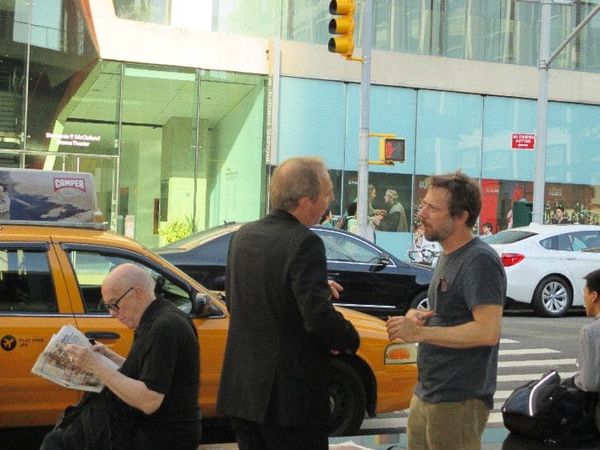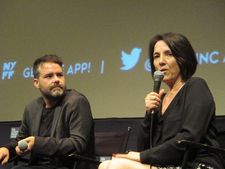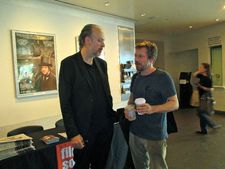 |
| Director Arnaud Desplechin sends Mathieu Amalric packing. Photo: Anne-Katrin Titze |
Joaquin Phoenix and Marion Cotillard give us characters who decide on survival in James Gray's The Immigrant. Mathieu Amalric as a therapist of veiled past confronts the title's Native American war veteran played by Benicio Del Toro in Arnaud Desplechin's resonant Jimmy P: Psychotherapy Of A Plains Indian, and Gloria (Paulina García) in Sebastián Lelio's film knows that you don't need to be in a costume drama to dress up. Free association may lead from a skateboard ride in (Gloria producer) Pablo Larraín's No to dancing skeletons, Arthur Ripley's gripping The Chase to John Huston's Let There Be Light, and Maria Falconetti's performance in Dreyer's Jeanne d'Arc to rickets.
Who are you? How does reinvention work? Do we have to change country, nationality, language, or profession to become ourselves?
The Immigrant
 |
| Joaquin Phoenix: "I became obsessed with rickets…" Photo: Anne-Katrin Titze |
Marion Cotillard plays Polish immigrant Ewa, who is separated upon arrival at Ellis Island from her sickly sister Magda who is moved to the infirmary and in danger of being sent back. The relatives do not come through for the sisters and Ewa is picked up by Bruno (Joaquin Phoenix) who runs a burlesque theater and makes his living from those struggling to survive.
Anne-Katrin Titze: Bruno's business are the desperate. At the beginning there wasn't much of a soul that was visible. The journey we take throughout the film with Ewa is finding glimpses of that soul in Bruno and in others in this business of despair. Is this something you were doing?
James Gray: I can say we sort of engineered the movie. I certainly engineered the movie on a script level in reverse. My co-writer, a wonderful guy named Richard Menello, who is now dead unfortunately, he and I talked about the ending first and how that would inform everything. That ultimately the ending made the story more about him, as much as about her because he is forced to confront his self-loathing. And to come to grips with the fact that just to survive is its own form of heroism. Certainly it was back then, and it is today, I think. Life is very hard. You know, people say, 'You're a movie director, what's hard about your life?" Everybody's life is hard. Everybody lives with great challenges. My [film's] whole journey's attempt to express was that in order to survive, he [Bruno] had to do these things. As horrible as they are, I didn't want to judge him for it. In the end we saw through this self-hatred some kind of deliverance. The way you come to write these things is a very emotional place, it's not a verbal or intellectual one. You try to think thematically as much as you can and in the end it's trying to communicate almost the unfathomable, the non-verbal mysterious. With that character I felt a close kinship, obviously a pimp… thank god my wife doesn't arrive here in New York. What I can say is that I empathised with his self-loathing. His struggle to survive, his struggle to battle, in my case depression, but certainly the struggle to battle the difficulties of living.
Joaquin Phoenix: That sounds good.
![The Immigrant director James Gray on Joaquin Phoenix: "he [Bruno] is forced to confront his self-loathing."](/images/newsite/Gray_Phoenix_The_Immigrant_2X_1_225.jpg) |
| The Immigrant director James Gray on Joaquin Phoenix: "he [Bruno] is forced to confront his self-loathing." Photo: Anne-Katrin Titze |
Director James Gray made it clear that he was not interested in making another romanticised arrival in New York as the gateway to paradise movie. His grandparents, who "came through Ellis Island in 1923" were part of the inspiration with much more than an anecdote of their first banana.
JG: "What was really the interesting thing for me was that it was not like the typical immigration story. When I saw movies about the American dream, they always seemed to be like (Gray changes his voice to some unidentifiable old man from the old world accent) 'I came to America, and it was fantastic and I loved it.' The truth is that my grandparents spoke really no English until the day they died, they never really assimilated at all, and there was a tremendous melancholy, to especially my grandfather, who used to talk about how he missed the old country. Which I never understood. I mean my grandmother's parents were beheaded by cossacks, so I never understood what he was missing really. But I found it interesting that he still had this pull for this place. To me it meant that the immigrant experience was a bit more complicated than, 'America's great.' That was one of the moods I was trying to impart. So many stories… about the trip on the boat and how dirty it was and how the men were very aggressive with the women."
Asked about his research for the role, Phoenix, who spoke as many words during the press conference as Robert Redford does as "Our Man" in his latest film All Is Lost, responded with: "Rickets. I became obsessed with rickets, but it didn't really have a place in the film. I kept trying to get it in there. It just wouldn't work. That's about all the research I did."
Gray said he cast Cotillard after he "had become friendly with her boyfriend," actor/director Guillaume Canet, "and we went out to dinner in Paris and I met her, and she and I started arguing about an actor whom she loved and I thought was overrated, and she threw a piece of bread at my head and she mentioned that she thought I was a jerk". She reminded him of a silent film actress because she had a "haunted quality… of Maria Falconetti in the Dreyer film." He wrote the movie for her and Phoenix.
Gloria
 |
| Director Sebastián Lelio with Paulina García on Gloria: "When I watch it, I understand that life is unpredictable." Photo: Anne-Katrin Titze |
Paulina García plays Gloria with glorious abandon in Sebastián Lelio's film about a woman who tries to find happiness. She is a divorcee, has grown children, goes to singles dances, works, does yoga, gets drunk, has an affair with the sheepish owner of an amusement park, and gets to tolerate a neighbor's visiting sphynx cat, the naked center of the film, an omen of kindness to come.
AKT: The dancing skeleton is a wonderful scene in the movie. The skeleton marionette of a street performer has black shoes and white gloves. I loved your reaction to it. What went on in your head while watching it dance?
Paulina García: I don't remember exactly what I was thinking. When I watch it, I understand that life is unpredictable. And that he was making a film that is full of life, full of unpredictable moments.
Sebastián Lelio: I was waiting to film that scene for ten years. I hadn't found a script to incorporate this. I saw this artist probably fifteen years ago in the streets of Santiago [Chile] and just loved it. I was waiting for the moment to find a story in which it could match. The same as to find a script to work with Paulina.
AKT: The skeleton could have also fit into another recent film from Chile, No by Pablo Larraín, who is also the producer of Gloria. The rhythm and energy reminded me of Gael García Bernal on the skateboard.
SL: There is lightness. There is lightness against the weight and darkness of death. So in a way, Gael floating on the skateboard and this skeleton saying,' you know, we're going to die but let's dance', I think you could connect that.
Jimmy P: Psychotherapy Of A Plains Indian
 |
| Co-screenwriter Kent Jones with Mathieu Amalric, star of Jimmy P: Psychotherapy Of A Plains Indian. Photo: Anne-Katrin Titze |
After the press screening for The Chase (1946) in the Revivals section of the treasure-packed 51st New York Film Festival, I crossed the street to meet up with Arnaud Desplechin, his star Mathieu Amalric and co-screenwriter, festival director Kent Jones at the Elinor Bunin Center. The trio was joking and reminiscing about a place "with cigars and tons of meat - only meat" where the missing member of the Jimmy P. Quartet, Benicio Del Toro, had abducted them to, following the North American premiere of their movie the evening before.
In the film, nationalities and accents blur to bring light, while psychoanalyst Georges Devereux (Mathieu Amalric) and patient, a Native American war veteran played by Benicio Del Toro embark on mapping out disclosures of the mind.
After Amalric was safely sent off by his director in a taxi to the airport, I had a chat with Desplechin on the sunny plaza at Lincoln Center. Here is an appetiser. The full conversation, including Freudian revelations, will be coming shortly:
AKT: I just saw Arthur Ripley's The Chase and thought how well the subject matter fits with your film Jimmy P: Psychotherapy Of A Plains Indian. The war veteran, the atmosphere, and the time vaguely. Because of the restoration I felt a bit like an audience member in 1946, or imagined it.
Arnaud Desplechin: Yes, I can see it. We didn't work that much with this film. Two films inspired us a lot. John Huston's Let There Be Light, [his suppressed 40mm film shot for the army in 1945 about returning soldiers]. The other was The Exiles (1961), Kent Mackenzie's movie about Native American guys and girls living in Los Angeles in the late 50s. It was so important for me that you could see Native American characters before the big native movement of the Sixties. What I mean is assimilated Native Americans, there was nothing like going back to your roots or going back to the reservation. It's this foolish hope to become American at last. It's a portrait of uprooted guys around Los Angeles. It's a wonderful film.





















